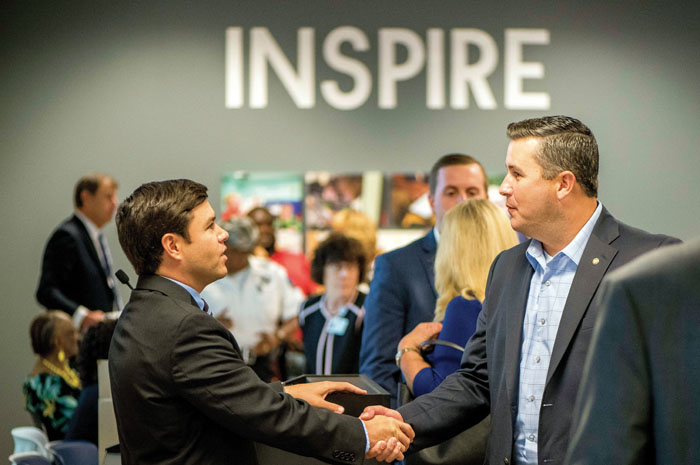Defining success under renewal: Educators explore new status for school system
Published 12:10 am Friday, November 2, 2018

- Former State Superintendent Mark Johnson, left, shakes hands with Rowan-Salisbury Board of Education member Dean Hunter after an August 2018 breakfast to kick off the renewal schools initiative at Wallace Educational Forum.
By Maggie Blackwell
For the Salisbury Post
SALISBURY — About 120 local educators gathered Thursday at Wallace Educational Forum to begin the process of identifying success for students under the Rowan-Salisbury Schools’ new renewal status. The two-day retreat concludes today.
The system was designated as a renewal district earlier this year, under a bill approved by the General Assembly in June. But there has never been a renewal school system in North Carolina before, and there’s no definition of how one would work. It will have charter-like freedom with techniques, funding and calendars.
Titled “Exploring True Accountability for Rowan-Salisbury Schools,” the retreat involves experienced educators in identifying what goals must be met.
Dr. Lynn Moody, superintendent, identified one teacher from each school in the system to participate in creating the vision for how to be a renewal system. These teachers, their principals and other administrators worked Thursday on defining how to identify student success once the system is in renewal status.
Consultants George Thompson and John Tanner guided Thursday’s session. Small groups discussed each concept presented and came up with their definition of how RSS might handle each component.
An article by Tanner that appeared in Page One magazine in September 2017 was required reading. The article cited the flaws in standardized testing across students with differing gifts and needs.
Tanner explained how testing ranks students by their proximity to average. A student’s achievement is above average, average or below average. Testing does not measure if they learned anything, if teaching methods were effective, or if they can apply what they learned.
“At no time can I assign a ‘why,’” Tanner said. “All I see is his proximity to average. Some orderings correlate with socio-economics, some do not. We draw a line somewhere relative to average and assign students to the left of that line as failures.”
In one exercise led by Tanner, teachers listed different ways to be smart across the top of the page. Some of the ways included music, art, mechanical, math and writing. Then the teachers graded themselves as super smart, sort of smart, or not smart at all in each area. Tanner said the profile of a successful person is to be super smart in two or three things, functional in a few things they must do, and not so smart in areas they don’t care for. This model bore out across the educators. Across all 100-plus educators, no two people had the same matrix.
“What you’ve identified in a tangible way,” Tanner said, “is that you owe it to every kid in your district to be good at something, and to have the knowledge that they can be. You need to engage kids in the areas where they are smart – that’s a must-have.”
Participants received five “Guiding Questions” to direct their work.
- As a renewal school district, to whom will we be accountable, and for what?
- Based on our hopes and dreams, what do we seek to accomplish and what will it look like in the classroom, in the schoolhouse, in the district and in the community?
- How do we ensure that accountability programs are in sync with and supportive of our direction?
- How do we ensure that other operating systems are in sync with and supportive of our direction?
- How can we use frameworks to frame our work and to ensure that strategic thinking precedes action?
At periods during the day, teachers had the opportunity to share their reactions. Some of the reactions:
“The system is set up for some kids to fail.”
“Students need at least one thing they’re good at.”
“We can’t all be above average.”
“A student may know the material but not be a good test taker. A child who has minimal understanding but good test skills may test higher.”
“Why has it taken so long for us to figure this out?”
Moody was pleased with the day’s progress.
“So far, today is going great,” she said. “The feedback has been deep and thoughtful. After these two days, the teachers will work with the teacher-led design teams at their respective schools. As a group, we will probably meet for one more day on goals, signaling and evidences. No later than March, we’ll take it all to the community for their feedback.”
The system must turn in an annual report to the state superintendent, and it’s not clearly defined what indicators are required in that report. Moody is working with the Department of Public Information to ensure they are aligned in expectations. Next month the Board of Education chair, vice-chair and Moody will meet with the deputy superintendent of DPI to identify the expectations for that end-of-year report.
Several school board members participated in the work. Board member Jean Kennedy said, “I am very pleased with the input from our teachers. I am fortunate to be in a group with teachers not only from all levels, but also the principal of our Early College and RCCC staff. We have shared some wonderful perspectives.
“We will be able to do this effectively. I am confident we will meet this challenge together. I’m very proud of what from our community – we must be sure we inspire our teachers to transform the educational process.”
The group will meet again to begin the process of defining measures using Thursday’s information as a basis. The retreat resumes at 8:30 a.m. today and continues until 2 p.m. The school board will hold a work session to reflect on the results. That meeting starts at 2:15 p.m. Both meetings are at the Wallace Educational Forum, 500 N. Main St.




